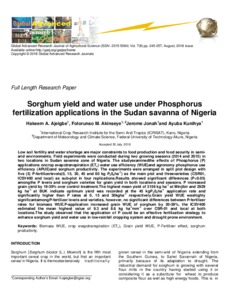Sorghum yield and water use under Phosphorus fertilization applications in the Sudan savanna of Nigeria
Abstract
Low soil fertility and water shortage are major constraints to food production and food security in semi-arid environments. Field experiments were conducted during two growing seasons (2014 and 2015) in two locations in Sudan savanna zone of Nigeria. The studyexaminedthe effects of Phosphorus (P) applications oncrop evapotranspiration (ETc) water use efficiency (WUE)and agronomy phosphorus use efficiency (APUE)and sorghum productivity. The experiments were arranged in split plot design with five (5) P-fertilizerlevels(0, 15, 30, 45 and 60 kg P205ha-1) as the main plot and threevarieties (CSR01, ICSV400 and local) as sub-plot in four replications.Results showed significant differences (P<0.05) amongthe P levels and sorghum varieties for grain yield in both locations and seasons. P increased grain yield by 19-39% over control treatment.The highest mean yield of 3156 kg ha-1 at Minjibir and 2929 kg ha-1 at BUK indicate optimum yield was recorded at the 45 kgP205ha-1 application rate and significantly higher than P rates at 0, 15 and 30kgha-1 respectively.Grain yield WUE washighly significantamongP-fertilizer levels and varieties, however, no significant differences between P-fertilizer rates for biomass WUE.P-application increased grain WUE of sorghum by 20-39%, the ICSV400 estimated the mean highest value of 9.3 and 8.6 kg ha-1mm-1 over CSR-01 and local at both locations.The study observed that the application of P could be an effective fertilization strategy to enhance sorghum yield and water use in low-rainfall cropping system and drought prone environment

